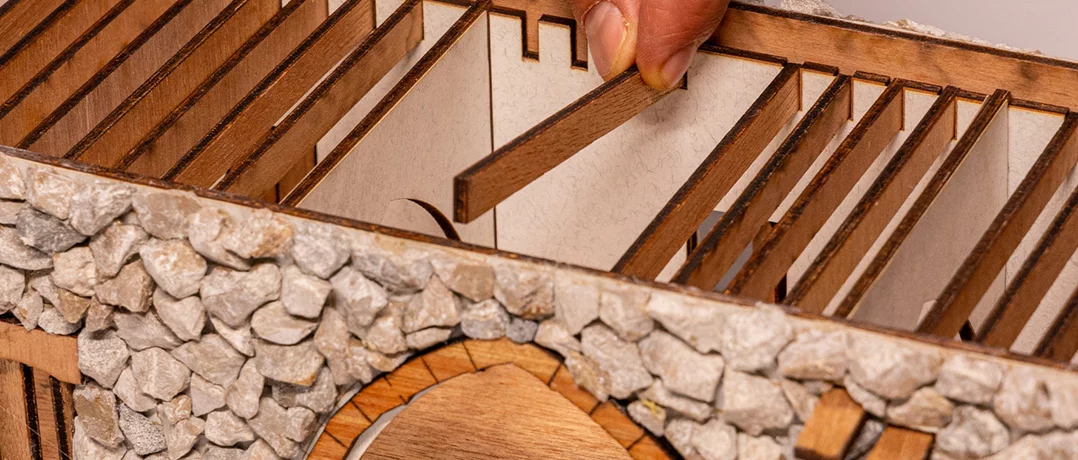With their miniature models of Lebanese heritage houses, siblings George and Jennifer Ghafary are rebuilding what time and neglect have taken away, exporting the spirit of Beirut, stone by stone, to the world.
From Leb with Love: miniatures of memory

“If people erase their heritage, they have no future, no roots, and when there are no roots, a tree does not grow.” This is how George Ghafary, co-founder of “From Leb with Love,” started his conversation with The Beiruter.
In their Beirut home, where sunlight spills across tables scattered with wooden fragments and tiny brushes, George Ghafary and his sisters Jennifer and Virginie are quietly rebuilding what time and neglect have taken away. Between his hands, George holds a miniature façade of a Lebanese house, triple arches, red-tiled roof, hand-painted shutters. It’s barely the size of a notebook, yet it carries the weight of a nation’s memory.
While one sister sketches the next design, a courtyard house in Gemmayzeh that may no longer exist, Jennifer, co-founder, manages the growing online project that has reached Lebanese communities across the world. Together, they’ve turned their family initiative, From Leb with Love, into a living archive of the country’s architectural soul, bringing its disappearing heritage houses back to life, one small model at a time.
Many of their models are based on real heritage homes, but they also create custom replicas upon request, miniature versions of family houses, ancestral villages, or beloved façades long gone. Each piece becomes a personal archive, a way for people to reconnect with their roots through craft and memory.
A house of memories
The idea, George explains, came from a place of both grief and purpose. “After the blast on August 4, 2020, I was walking through Gemmayzeh and Mar Mikhael and saw houses collapsing, one by one, erased. I thought: how can we keep their stories alive? How can we teach our children what these houses mean?”
Each model is more than an object; it’s a fragment of identity. The Ghafarys recreate the houses that once shaped the country’s skyline, the Ottoman-era balconies of Achrafieh, the arches of Ras Beirut, the sea-facing villas of Raouché. With Jennifer’s background in game design and George’s passion for heritage preservation, they designed models that anyone could assemble, like puzzles of memory.
“From Leb with Love is not just about architecture,” George says. “It’s about telling stories through houses, the people who lived there, the time they were built, the materials used. Every stone has a soul.”
Made in Lebanon, for the world
The process begins with meticulous research. Virginie draws the plans using AutoCAD, based on historical photos and site visits. Then, each detail, windows, doors, balustrades, is laser-cut in Beirut using recycled wood. The pieces fit together like a delicate mosaic
“We make sure everything is produced locally,” he says. “Even the packaging, even the prints. It’s a way of supporting small artisans here.”
Each kit includes a brief history of the house and a guide to traditional Lebanese architecture. Some of their models are now shipped to Lebanese expatriates around the world, including Canada, the U.S., France, and Australia. “People write to us saying, ‘When I built it, I felt like I was back home.’ That’s the point, to give people something tangible to hold on to.”
In an age when Beirut’s skyline is being rewritten by glass towers and real estate greed, From Leb with Love offers an act of resistance: a quiet, handcrafted form of cultural archiving.
Beyond nostalgia
But George refuses to let the project become just a nostalgic souvenir. “We don’t want people to look at these houses and say, ‘Oh, Lebanon used to be beautiful.’ We want them to realize that this beauty can still be part of our future.”
He speaks passionately about education, how the models can be used in schools to teach history, design, and identity.
Architecture is our language. The triple arches you see, people say they come from the French, Italians, or the Ottomans, but no. They were born here. They’re ours. This is our architectural DNA.
For George, every model carries that message: Lebanon’s heritage is not a relic of the past, but a blueprint for resilience.
Saying goodbye, gently
Not all moments in the workshop are hopeful. Some are quietly painful. “It’s exhausting,” George admits. “You spend hours recreating a house you know is going to be gone. It’s like you’re saying goodbye to something you love, but you want to leave a memory of it.”
Still, the act of rebuilding, even in miniature, feels redemptive. The Ghafarys are turning loss into creation, nostalgia into knowledge.
When we finish a piece, it’s like reviving a heartbeat! That’s the reward.
Their dream now is to expand the collection into an open exhibition, a miniature Lebanon that people can walk through, learn from, and touch. They envision an educational platform, workshops for children, collaborations with universities, and diaspora communities.
A future in fragments
As the models take shape, piece by piece, so does a quiet form of hope. For George and Jennifer, these tiny houses are not merely objects, they’re proof that heritage can survive even when the walls fall.
“Lebanon is not dead,” George says firmly. “We still have so much to offer the world. We have culture, beauty, stories, we just need to believe in them again.”
On the table, a row of red roofs glows under a beam of afternoon light. They look like a small city, untouched by time, a Lebanon rebuilt in miniature, but remembered in full.



.webp)